Finally, finally, finally, I am getting up the recipes I learned at the cooking class I took at the restaurant Taste of India in Dharamsala. It was a really fun experience, a bit pricey ($18) but totally worth it! I learned how to cook 10 recipes from a woman in the basement of the guesthouse adjoining the restaurant, along with two middle-aged guys from Britain. We just watched and copied everything down, not participating other than making a couple samosas, but I really didn't mind. It was just so fun watching her make the recipes.
On the first day, we learned how to make Aloo Gobhi, Palak Paneer, Chapati, Dal Makhani, Yellow Dal, and Malai Kofta. I am posting all recipes but the Malai Kofta, because I really didn't think it was good at all -- much to sweet, and not really tasting like Malai Kofta to me. The others, however, were all great.
Recipes:
Aloo Gobhi
This is a really easy dish, but one of my favorites out of everything we made. It's a pretty dry curry. Serve with rice or bread, and preferably a dal.
Ingredients:
4 serving spoons (she used this spoon to measure a lot, and I think it was a little more than a tbsp, in between that and 1/4 cup) vegetable oil
1/2 tsp cumin seeds
2 tsp garlic, chopped
2 tsp fresh ginger, chopped
500 grams cauliflower, chopped (or one big head of cauliflower)
250 grams potatoes, peeled and chopped (or 4 medium potatoes)
1 green chili, chopped (optional -- we didn't use it and I really don't think it's necessary. This has tons of flavor.)
1/4 tsp turmeric powder
1/4 tsp red chili powder
1 tsp coriander powder
1 tsp salt
1/2 tsp garam masala
2 tsp fresh coriander leaves, chopped
Heat the oil well in a large frying pan. Add the cumin. When the cumin pops, add the garlic and ginger. Stir it briefly and add the vegetables and green chili (if using.) Mix and cook for 1 minute. Then add all the spices (turmeric, red chili powder, coriander powder, salt, and garam masala.) Mix well and add 1/4 cup of water. Cover and cook at a low temperature for at least 20 minutes. The vegetables should be soft. Remove from heat and stir in fresh coriander. Serve hot!
Palak Paneer
YUM. Tastes just like at the restaurant, especially with the flavor of fenugreek leaves (hard to find but worth it.) Serve with hot chapati or parantha.
500 grams spinach (or one big bunch of spinach)
2 medium red onions, finely chopped and then crushed in a blender or food processor
1 1/2 tsp ginger/garlic paste (put the same amount of each into a blender and grind to a fine paste, adding a little water if necessary.)
200 g tomato puree (Boil tomatoes for 2 minutes, remove the skin, and crush in a blender.)
4 serving spoons of vegetable oil or ghee
1/2 tsp cumin seeds
1/2 tsp coriander seeds
1/4 tsp red chili powder
1 tsp coriander powder
1 tsp salt
1/2 tsp garam masala
1 tsp fenugreek leaves (REALLY IMPORTANT. I had never before seen or heard of fenugreek leaves, only fenugreek seeds. The leaves are nothing like the seeds in flavor. They have a really distinctive taste and really add to this dish. They come in bags, dried, at any Indian market.)
200 g paneer (recipe will follow)
2 tsp cream
2 tsp butter
2 tsp fresh coriander leaves, chopped
How to make paneer:
Boil 2 liters of milk. Add 1/2 cup lemon juice, and boil for 5 more minutes. Drain the milk into a cheesecloth. Make the cheese into one big ball and squeeze out the liquid. Wrap the block in a cloth, put something very heavy on top, and let rest for at least two hours. Then, cut into cubes to use in the palak paneer.
Recipe for palak paneer:
Cut spinach roughly, wash it, and boil it for 10 minutes in 1/2 cup water. When it's done, grind it with any remaining water in a blender.
Heat the oil in a pan. When it's well-heated, add the cumin and coriander seeds. When the seeds begin to pop, add the crushed onions. Cook for 8 to 10 minutes. When the onion mixture separates oil on the corners, it is cooked. Add 1/2 cup water and ginger/garlic paste. Stir, cook for two minutes, and add the remaining spices. Cook at a low temperature for two more minutes. Add the tomato puree and cook 2-3 minutes more. When you see oil on top of the tomatoes, they are cooked. Add spinach to the sauce. Mix well, cover, and cook for 5 more minutes. Add paneer and cook 5 minutes more.
Add cream and butter at the last minute, and serve.
Chapati
Ingredients:
2 cups wheat flour (I use whole wheat and white flour mixed)
1/2 tsp salt
2 tbsp oil
1 cup water (or more or less... add a little add a time and stop once you have achieved a soft dough.)
Combine all ingredients, kneading only until they are well-mixed. Cover the dough and let rest for 30 minutes. Form the dough into golf ball-sized balls. Coat them in flour and roll them out one and a time. Heat a griddle and do not begin to cook chapati until it is very well-heated. Cook each one only about a minute (or less) on each side. They should puff up beautifully. Serve with curry!
Dal Makhani
This black dal is very popular in Punjab.
200g black lentils and 50g red kidney beans, mixed together, washed, and soaked for at least 7 hours.
2 cinnamon sticks
2 whole black cardamom pods
4 whole green cardamom pods
5 cloves
1/4 tsp red chili powder
1 tsp salt
3 tbsp oil or ghee
2 tsp fresh ginger, finely chopped
2 medium tomatoes, chopped
1/2 cup milk
2 tsp fenugreek leaves
2 tbsp fresh cream
2 tsp butter
Bring 2 1/2 liters of water to a boil. Add the dal, whole spices, red chili powder, and salt. Cover and cook for one hour, or until dal is very soft.
In a small frying pan, heat the oil or ghee. Add the fresh ginger and cook for 1-2 minutes. Then add tomatoes. Cook 2-3 more minutes, and then add to the dal, along with the milk and fenugreek leaves. Cook 2-3 more minutes, then remove from heat, add cream and butter, and serve.
Yellow dal:
Ingredients:
2 cups yellow dal, washed and soaked for at least 30 minutes.
1/4 tsp turmeric powder
1 tsp salt
3 tbsp oil or ghee
1/2 tsp cumin seeds
1/2 tsp mustard seeds
A pinch of asafoedita (hing)
2 medium onions, finely chopped
2 tsp finely-chopped garlic
2 medium tomatoes, chopped
1/4 tsp red chili powder
1/2 tsp garam masala
2 tsp fresh coriander
Bring 2 liters of water to a boil. Add dal, turmeric, and salt. Cook for 30 minutes.
In a separate pan, heat the oil or ghee well. Add the cumin seeds, mustard seeds, and asofoedita. After they begin to pop, add the chopped onion and cook 2-3 minutes more. Add the garlic, and after a minute, the tomatoes. Cook 2-3 minutes. Add the chili powder and garam masala. Add the mixture to the dal. Cook two minutes, then remove from heat, add fresh coriander, and serve.
this blog is documenting what we eat. it's about food: growing the crops, the philosophy and ethics, the kitchen, food prep, and recipes. we also write about the culture, the methods, and anything mildly related.
Saturday, April 9, 2011
Momos
Finally, I am getting the momo recipes up! Several weeks ago, Max and I took a 2-hour cooking class at Sangye's Kitchen on how to make momos. It was a really fun experience. Sangye's kitchen was tiny, and his stove little more than what we had at our guesthouse (before the gas started leaking.) He was also really nice and helpful. He runs these classes twice a day, six days a week. Monday and Friday he teaches breads, Tuesday and Saturday noodle soups, and Sunday and Thursday momos.
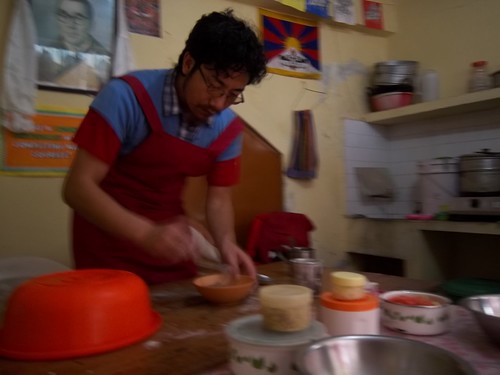
What are momos, you may ask? They are Tibetan dumplings. They are usually filled with either vegetables, potato, or meat, but in our class we made veggie, spinach and cheese, and CHOCOLATE.
How to make momos:
The recipe makes about 70 momos. Half the recipe if you are serving fewer people.
To make the dough:
Ingredients:
1/2 kg white flour
1 tsp baking powder
2 cups water
Sift flour and baking powder together in a mixing bowl. Add water slowly and squeeze dough together until well-mixed. Place on a floured surface and knead for five minutes. Cover with a wet cloth and let sit for five minutes while you prepare the fillings.
Vegetable filling:
Combine the following:
1/4 head of cabbage finely chopped
1 large carrot finely chopped
1 large onion finely chopped
50 grams uncooked glass vermicelli
1 tsp garlic finely chopped
1 tsp ginger finely chopped
1 tsp salt
1/8 tsp black pepper
4 tbsp neutral vegetable oil of your choice
Potato filling:
Combine the following:
2 large potatoes cooked, peeled, and mashed
2 tsp spring onion finely chopped
1 tsp garlic finely chopped
1 tsp ginger finely chopped
1 tsp salt
1/8 tsp black pepper
4 tbsp neutral vegetable oil
Spinach and cheese filling:
Combine the following:
1/4 of a bunch of fresh spinach finely chopped
25 grams any cheese, grated
1 onion finely chopped
1 tsp garlic finely chopped
1 tsp ginger finely chopped
1 tsp salt
1/8 tsp black pepper
4 tbsp neutral vegetable oil
Chocolate filling!
Ingredients:
4 tbsp neutral vegetable oil
2 tbsp flour
2 tbsp sesame seeds
2 tbsp sugar
About a half cup dry hot chocolate mix (Although this is an approximation -- use how much looks good to you!)
Heat the oil in a frying pan at a low temperature and add all ingredients. Cook until golden-brown, stirring constantly. Allow to cool before filling momos.
Making the momos:
Prepare water in a steamer to steam the momos.
Knead the dough a little to soften it. Make the dough into a long sausage shape. cut into lengths as wide as 1/2 a finger. Press them down into little disks. You can kind of see here:
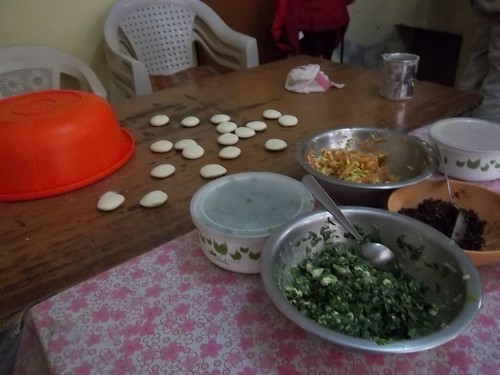
Roll each one out into a round shape. Now you are ready to form the momos. We learned how to make three momo shapes:
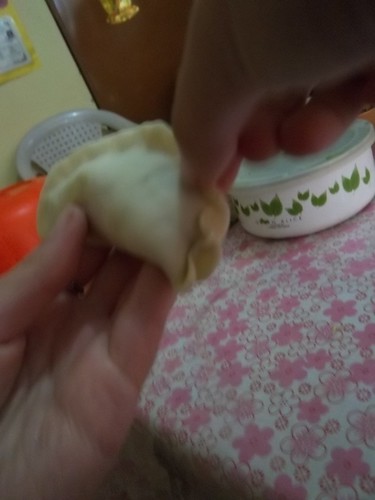
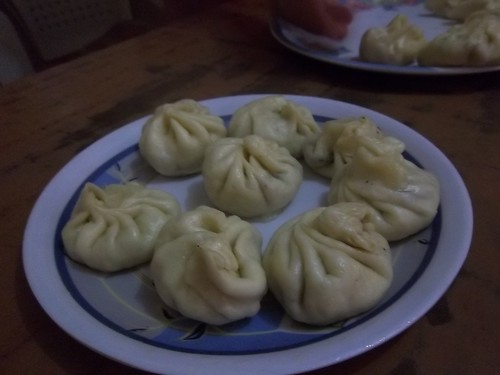
You can kind of see all three here:
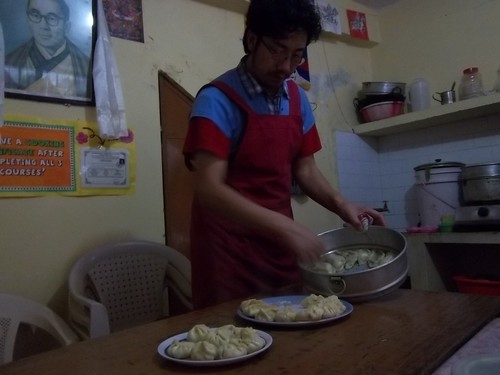
The easiest way is to just put a scoop of filling in the center of each one and seal the edges with water. You could also try imitating the photos -- I remember the rolled edge was quite easy, but I have no memory of exactly how to do it!
Place prepared momos in the top of the steamer and steam for 15 minutes. They should feel pretty dry when done, rather than sticky. Serve hot with soy sauce and chili sauce! (Except the chocolate; that would be weird.)

What are momos, you may ask? They are Tibetan dumplings. They are usually filled with either vegetables, potato, or meat, but in our class we made veggie, spinach and cheese, and CHOCOLATE.
How to make momos:
The recipe makes about 70 momos. Half the recipe if you are serving fewer people.
To make the dough:
Ingredients:
1/2 kg white flour
1 tsp baking powder
2 cups water
Sift flour and baking powder together in a mixing bowl. Add water slowly and squeeze dough together until well-mixed. Place on a floured surface and knead for five minutes. Cover with a wet cloth and let sit for five minutes while you prepare the fillings.
Vegetable filling:
Combine the following:
1/4 head of cabbage finely chopped
1 large carrot finely chopped
1 large onion finely chopped
50 grams uncooked glass vermicelli
1 tsp garlic finely chopped
1 tsp ginger finely chopped
1 tsp salt
1/8 tsp black pepper
4 tbsp neutral vegetable oil of your choice
Potato filling:
Combine the following:
2 large potatoes cooked, peeled, and mashed
2 tsp spring onion finely chopped
1 tsp garlic finely chopped
1 tsp ginger finely chopped
1 tsp salt
1/8 tsp black pepper
4 tbsp neutral vegetable oil
Spinach and cheese filling:
Combine the following:
1/4 of a bunch of fresh spinach finely chopped
25 grams any cheese, grated
1 onion finely chopped
1 tsp garlic finely chopped
1 tsp ginger finely chopped
1 tsp salt
1/8 tsp black pepper
4 tbsp neutral vegetable oil
Chocolate filling!
Ingredients:
4 tbsp neutral vegetable oil
2 tbsp flour
2 tbsp sesame seeds
2 tbsp sugar
About a half cup dry hot chocolate mix (Although this is an approximation -- use how much looks good to you!)
Heat the oil in a frying pan at a low temperature and add all ingredients. Cook until golden-brown, stirring constantly. Allow to cool before filling momos.
Making the momos:
Prepare water in a steamer to steam the momos.
Knead the dough a little to soften it. Make the dough into a long sausage shape. cut into lengths as wide as 1/2 a finger. Press them down into little disks. You can kind of see here:

Roll each one out into a round shape. Now you are ready to form the momos. We learned how to make three momo shapes:


You can kind of see all three here:

The easiest way is to just put a scoop of filling in the center of each one and seal the edges with water. You could also try imitating the photos -- I remember the rolled edge was quite easy, but I have no memory of exactly how to do it!
Place prepared momos in the top of the steamer and steam for 15 minutes. They should feel pretty dry when done, rather than sticky. Serve hot with soy sauce and chili sauce! (Except the chocolate; that would be weird.)
Sunday, April 3, 2011
more recipes coming
hey, sorry for the big gap. next week zoe is taking a two day indian cooking class where she will learning something like 10 recipes. also we will get the momo recipe up soon too, because momos are awesome.
Sunday, March 6, 2011
coconut fun
i will let it remain in mystery of how we opened it for now.... bring me a coconut and i will show you how!
Saturday, February 26, 2011
Dal and Cabbage Curry
Meanwhile, in Cambridge, Massachusetts, USA, Mana and Pop cooked Max and Zoë's recipes for dal and cabbage curry. They were delicious. I'm pretty sure they followed the official Indian instructions almost to the letter. Pop made the dal (I think he said he used a slightly different kind of dal?), and Mana made the cabbage, using a bit less coconut than Zoë specified. She wondered if it would come out differently because she wasn't using fresh coconut right from the shell. Here are several pictures of Isaac enjoying our meal:


meat ethics in india
it is common belief that cows are not consumed in india. i arrived in this country thinking that but found out otherwise. we had a discussion with a local about meat consumption in india. in the cast system brahmans are the only ones required to be vegetarian. it is quite common that the poor consume meat.
back in the day when it was illegal to eat cows the poor farmers or peasants would pay off the police men to eat beef in peace. considering the farmers'/peasants' situations it is quite ethical to consume the cow in a country with such high malnutrition.
also back in the day, at birth often the female calves were killed or consumed at a very young age. the bulls were valued a lot for their ability to do work in the field. now it has become the opposite, the bulls are needed less because of cheap fossil fuels and the females are valued because of the high milk demand. i believe you would find a similar pattern in the united states.
i have yet to see beef on the menu, but you never know. as we venture further north i think we will see more meat on the menu. alexis, a fellow traveler, told us about going to remote villages and the families making her a meal of chicken broth or sauce and these black balls. she was informed by the villagers these black balls were almost completely fiber and were to be soaked in the chicken sauce. she said you couldn't chew them because they would immediately fuse to your teeth.
considering the village was probably half starving she said she could not turn the meal away without being offensive. furthermore, she had to finish the meal as to not be rude and recognize the importance and value of food to those people.
i expect we may run across this situation. despite being vegetarian, i am prepared to eat whatever is offered as long as it's cooked well. i really cannot imagine doing anything else. it is difficult playing with food ethics on such a large scale.
i had a discussion about vegetarianism and ethics with a local man. he had quite a global view, the line he said that has stuck with me the most is: "how can you argue about fertilized and non-fertilized eggs when so many people are hungry? the majority of people eat what they can."
it was a difficult discussion and made my gut turn. it was a shot directly to the heart of my food ethics. he made veganism, the diet i consider most ethical, seem wrong. the fact is that vegans cannot eat entirely local, at least not in maine, without becoming deficient in something. he is right, choice is luxury, but his view was so completely global, a dog-eat-dog view.
i consider local the best and most responsible when teamed up with veganism. obviously these two cannot work together completely, but my buddhist perspective kicks in that i am not greater than a cow, and feel nothing different from a cow or any other creature.
i did not mention it to him, but he did talk about how i could either treat local animals really badly by eating them or treat some humans really badly exploiting them overseas for some stupid exotic fruit.
the day the dog killed the monkey i tried to explain to one of the people involved in the incident (10-year-old Milan) the monkey probably had a heart attack. he looked at me, confused, and said, "monkey has a heart?" india in general seems a bit more distant from animals, especially in dog treatment, compared to the states.
as for conclusion about my current food ethics since that chat, i still prefer vegan/local with some mindful cheating, and for now vegetarianism while i travel. what makes me feel awful about it is i know i am picking the lesser of the two evils, neither is really that close to perfect or fossil fuel-free. it would take the commitment of really going back to the land and networking within a few miles to get relatively close.
Tuesday, February 22, 2011
kitchen equipment
I thought you might appreciate a bit of a description of the kitchen at the farm, so that you have an idea of what we were working with when we made all these recipes! Max said: "At first I was afraid of it, but then I realized it's the most awesome kitchen ever." This sums it up pretty well. It's basic, but it has everything you need to make delicious food -- in many ways, it's more well-stocked than my kitchen at home.
The highlight of the kitchen is definitely the grinder. It came with the house (they had to pay a couple thousand rupees extra) and Max estimates that it weighs about 500 lbs. That may be a slight exaggeration, but you get the idea. Here I am (a little blurry) grinding masala paste:
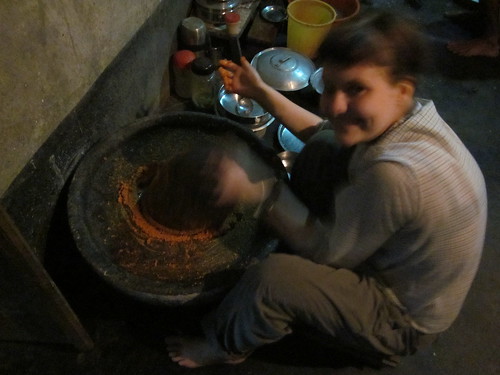
The stove in the kitchen is simply an open fire with three holes on top for heavy metal pans. Max making pancakes over the fire:
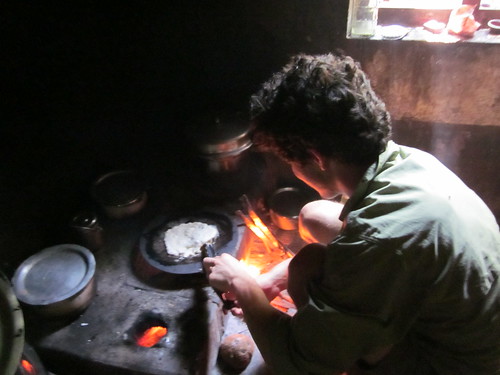
Health risks aside, it is a very effective stove, and pleasantly warm in the morning when we manage to get up at six or seven to help make breakfast.
Vegetables are kept in a corner that's shady throughout the day. See the coconuts in the back?
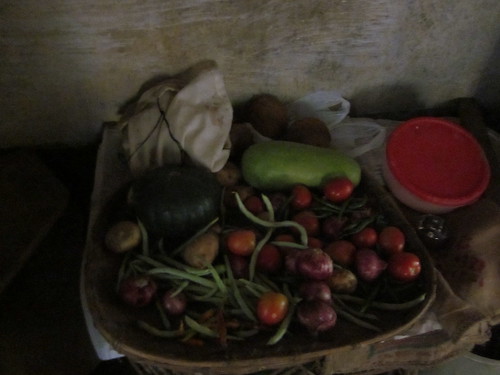
Bananas hang from the ceiling.

Water is kept in this large silver container.
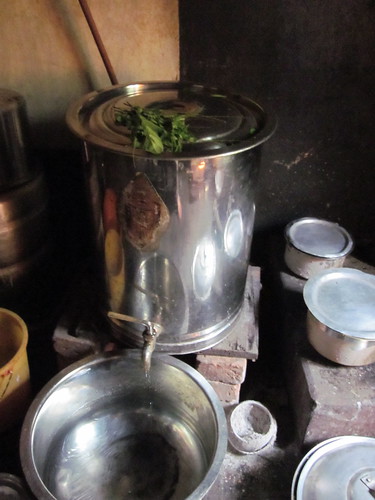
Curry leaves are kept on top of the water container. When I asked what they were, no one knew the name in English. Ranjana told me, "You find these leaves in all Indian cooking, I think." For a while I couldn't figure it out, and I thought maybe they were something I'd never heard of before. Then I figured it out: curry leaves! Of course! They have a nice smell and nice mild (but distinct) flavor. Y'all can get them at the Indian market in South Portland.
Various spices, sugars, and condiments.
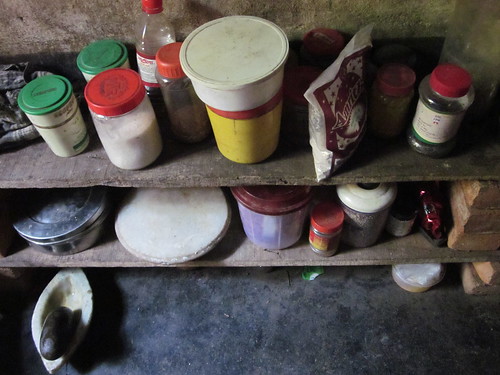
Plates, cups, bowls, and minimal silverware (i.e. three spoons) -- all made of metal.
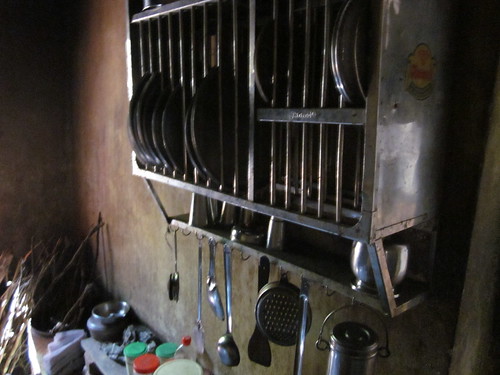
Various covered pots and pans full of leftovers sit here throughout the day. Most are eaten with meals or as snacks. The rest go to Gunda, the neighbor's dog.
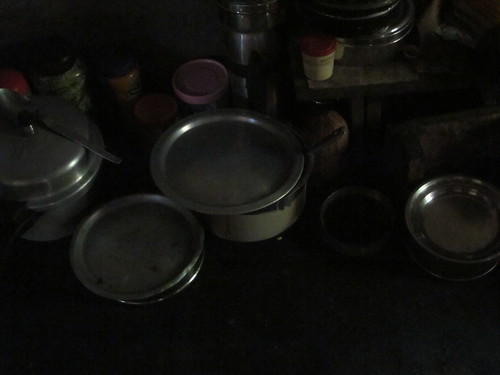
I really appreciate this kitchen and had lots of fun here cooking with Ranjana and Max. Also, my ability to grind masala improved significantly, and hopefully the strength of my left arm as well! I'll miss the farm kitchen for sure.
The highlight of the kitchen is definitely the grinder. It came with the house (they had to pay a couple thousand rupees extra) and Max estimates that it weighs about 500 lbs. That may be a slight exaggeration, but you get the idea. Here I am (a little blurry) grinding masala paste:

The stove in the kitchen is simply an open fire with three holes on top for heavy metal pans. Max making pancakes over the fire:

Health risks aside, it is a very effective stove, and pleasantly warm in the morning when we manage to get up at six or seven to help make breakfast.
Vegetables are kept in a corner that's shady throughout the day. See the coconuts in the back?

Bananas hang from the ceiling.

Water is kept in this large silver container.

Curry leaves are kept on top of the water container. When I asked what they were, no one knew the name in English. Ranjana told me, "You find these leaves in all Indian cooking, I think." For a while I couldn't figure it out, and I thought maybe they were something I'd never heard of before. Then I figured it out: curry leaves! Of course! They have a nice smell and nice mild (but distinct) flavor. Y'all can get them at the Indian market in South Portland.
Various spices, sugars, and condiments.

Plates, cups, bowls, and minimal silverware (i.e. three spoons) -- all made of metal.

Various covered pots and pans full of leftovers sit here throughout the day. Most are eaten with meals or as snacks. The rest go to Gunda, the neighbor's dog.

I really appreciate this kitchen and had lots of fun here cooking with Ranjana and Max. Also, my ability to grind masala improved significantly, and hopefully the strength of my left arm as well! I'll miss the farm kitchen for sure.
Bimboli pickle
Before we left Sangatya Farm, I had the really fun opportunity to participate in the making of bimboli pickle. Bimboli is a small, green, extremely sour and bitter fruit that has the consistency of apple and is white inside. It's in season now, so on the farm it's all we eat for pickle -- and we eat pickle with lunch and dinner every day. The first time I had bimboli pickle, I didn't like it at all, finding it much too strong. Now I can't believe that. Something sour really, really adds to the overall experience of this food, and now I savor every bite of bimboli pickle.
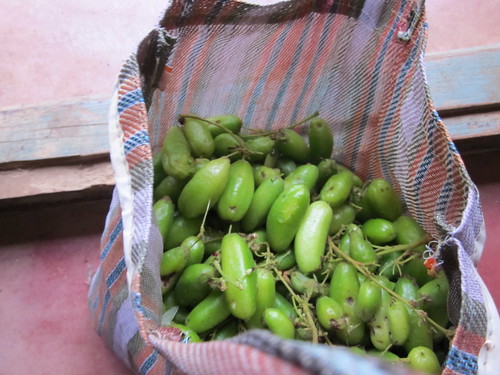
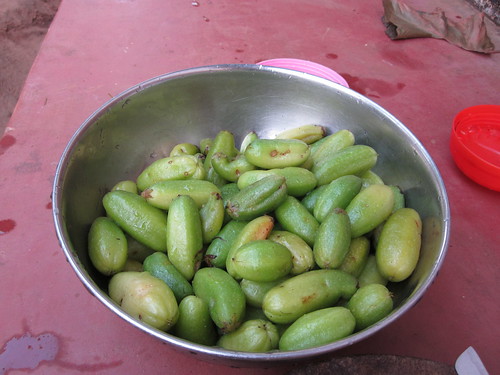
The bimboli experience starts with this tree. Unfortunately I failed to get a photo of it before or during the harvest. Harvesting bimboli consisted of watching Milan climb WAY up this tree, picking bimboli clusters as he went and tossing them down to me. I caught most in a big striped bag. The rest I collected from the ground. It was incredible watching this little boy scurry up this tree so easily and pick the bimboli.
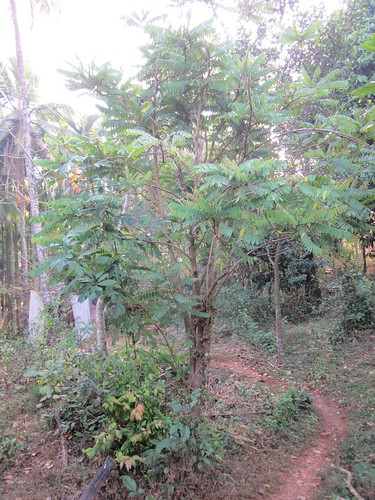
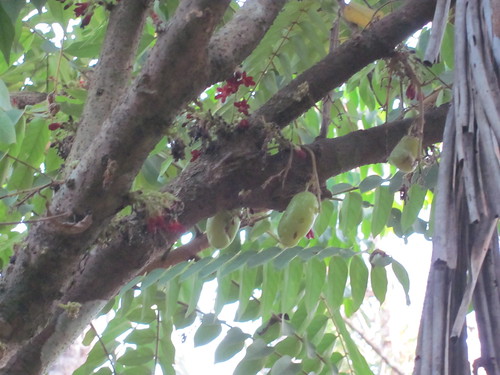
Next, I washed and chopped the fruit. It took over two hours in all, and I only did maybe two-thirds of it (Svetlana and Max helped.) I put the bimboli in jars.
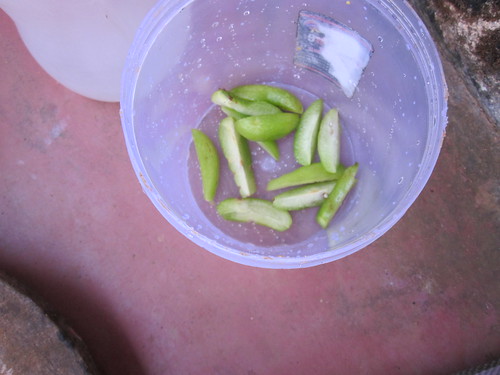

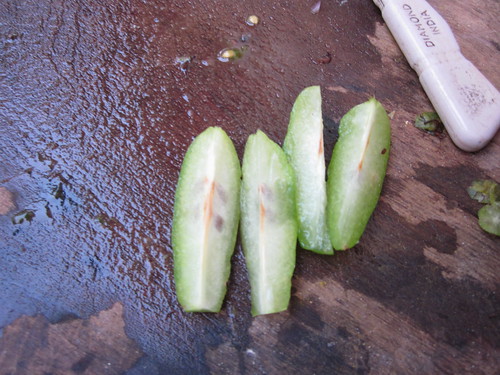
All the jars of bimboli:
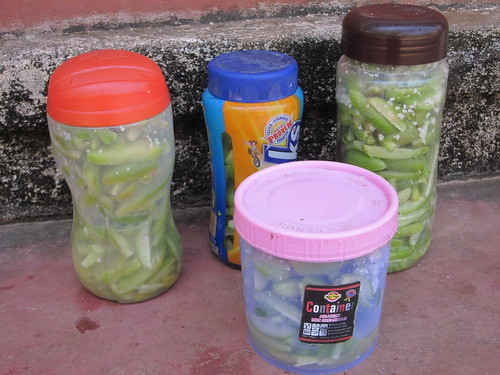
Next, Ranjana added salt and let the pickle sit overnight. It reduces in size considerably and you can consolidate the bimboli.
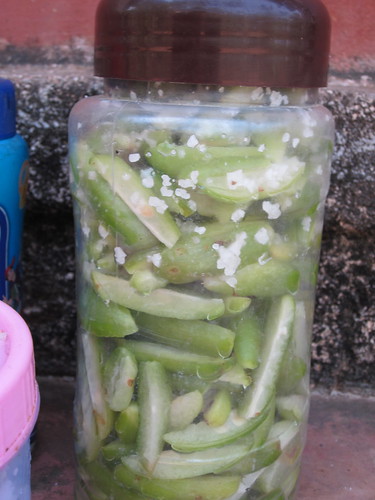
Then Ranjana made the masala. I did get to watch her do this, and I wrote down the recipe, but now I don't have it with me and I don't remember it exactly. I will, however, do my best. First, you toast, dry, 3 tbsp each whole cumin and whole fenugreek seeds in a frying pan. After they are brown, remove from heat and grind to a fine powder. Heat about 4 tbsp oil in a frying pan, and add mustard seeds. When they begin to pop, add the spices you just ground as well as three tsp chili powder. Wait for the mixture to cool (at least an hour.)
Finished bimboli pickle. Notice the jar's already half-empty. Bimboli is yummy.
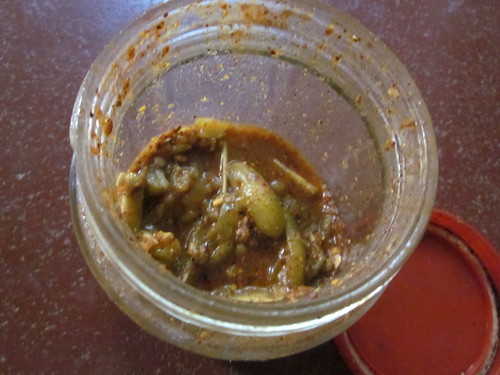
I have enjoyed making pickle in the past, but once I go home, I will definitely expand my repertoire! Pickle goes so well with everything, even just curry and rice. That sour flavor adds something really essential to a meal, I think. (Same is true for sauerkraut. It makes a sandwich about 100% better.) Ranjana recommended that I substitute green chilis slit in half. But she said that chili pickle should be made with about twice as much oil. Other ideas: garlic, onion?


The bimboli experience starts with this tree. Unfortunately I failed to get a photo of it before or during the harvest. Harvesting bimboli consisted of watching Milan climb WAY up this tree, picking bimboli clusters as he went and tossing them down to me. I caught most in a big striped bag. The rest I collected from the ground. It was incredible watching this little boy scurry up this tree so easily and pick the bimboli.


Next, I washed and chopped the fruit. It took over two hours in all, and I only did maybe two-thirds of it (Svetlana and Max helped.) I put the bimboli in jars.



All the jars of bimboli:

Next, Ranjana added salt and let the pickle sit overnight. It reduces in size considerably and you can consolidate the bimboli.

Then Ranjana made the masala. I did get to watch her do this, and I wrote down the recipe, but now I don't have it with me and I don't remember it exactly. I will, however, do my best. First, you toast, dry, 3 tbsp each whole cumin and whole fenugreek seeds in a frying pan. After they are brown, remove from heat and grind to a fine powder. Heat about 4 tbsp oil in a frying pan, and add mustard seeds. When they begin to pop, add the spices you just ground as well as three tsp chili powder. Wait for the mixture to cool (at least an hour.)
Finished bimboli pickle. Notice the jar's already half-empty. Bimboli is yummy.

I have enjoyed making pickle in the past, but once I go home, I will definitely expand my repertoire! Pickle goes so well with everything, even just curry and rice. That sour flavor adds something really essential to a meal, I think. (Same is true for sauerkraut. It makes a sandwich about 100% better.) Ranjana recommended that I substitute green chilis slit in half. But she said that chili pickle should be made with about twice as much oil. Other ideas: garlic, onion?
Monday, February 14, 2011
ranjana
ranjana is the chef who we have been learning from. she has been very kind in taking the time to explain to us how she makes each dish. she is from east india but does not stick to a specific cooking style of any region in india.
we think she considers us as really goofy people writing down all the recipes that she knows from memory. we don't mind, it is completely worth it. a lot of the recipes and spice mixes she makes up on the spot, and usually we are there to write it down.
she is a really great person, she is sort of the glue of this community and her work seems to be done in the background. she cooks pretty much all the meals with the aid of us and shree kumar. she also does gardening, farm work, and in the afternoon during resting time she is often spinning cotton.
although many of us work out in the field under the blazing sun we would not be there without ranjana feeding us so well. i come across a guilt feeling quite often because she is usually out in the field with us. the amount of work she does is absolutely incredible.
Sunday, February 13, 2011
Making coffee
We have made coffee three times so far. The first time we used the coffee we found on the farm, which came out a bit strange and definitely too weak. However, no one on the farm could drink it because they found it so unbelievably strong! And unsweetened, even though we put plenty of maple syrup in.
We set up our shiny red filter-holder:
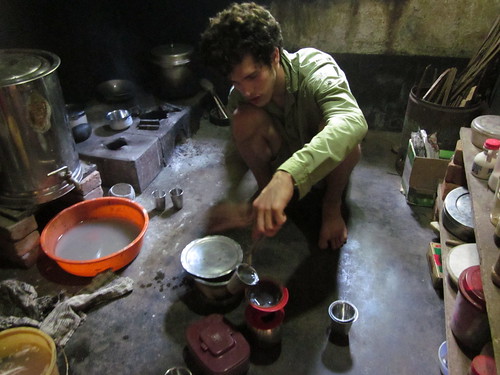
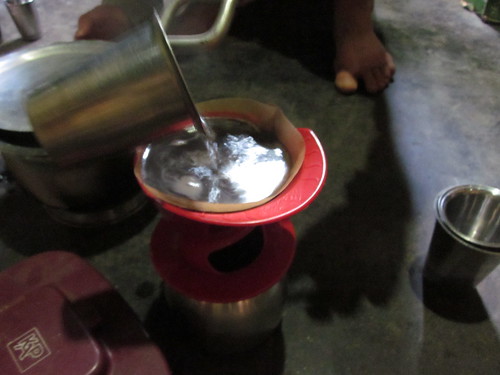
What could improve such terrible coffee?
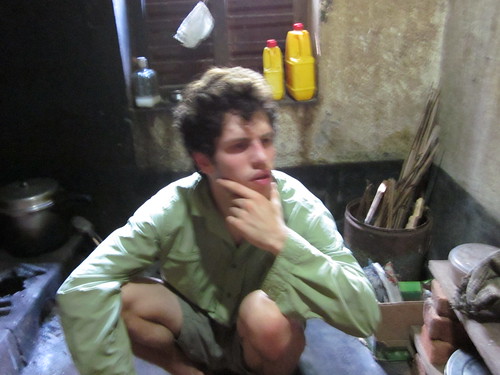
Maple syrup, clearly.
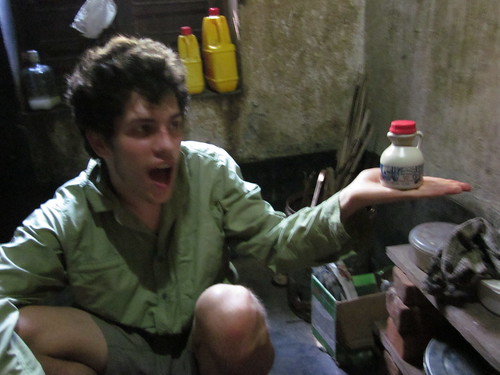
The set-up (note the lumpy milk):
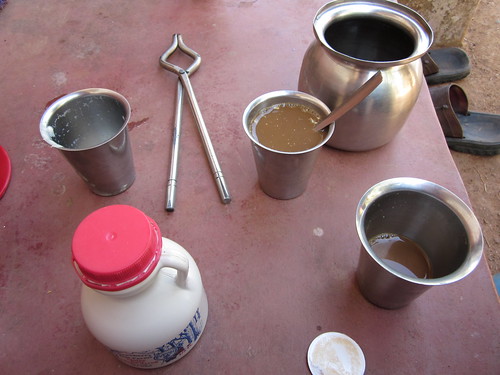
We set up our shiny red filter-holder:


What could improve such terrible coffee?

Maple syrup, clearly.

The set-up (note the lumpy milk):

Simple dal and cabbage curry
We ate these together for lunch today, but they can also be eaten separately with different dishes. The cabbage curry (a dry dish) should be paired with a wet one like simple dal, and vice versa.
I cooked both of these this morning, starting at seven, with Max and Shreekumar. Usually all the cooking for lunch is done in the morning so that we can use the breakfast fire, and then the dishes sit until lunchtime.
Simple dal:
Ingredients:
2 cups toor dal or chana dal
2 green chilis, slit in half lengthwise
1 2-inch-by-2-inch piece of fresh ginger, chopped very finely
3 tbsp coarse salt, or to taste
About 2 tbsp oil
3 tsp mustard seeds
2 dried red chilis, broken into pieces
30 curry leaves
1 heaping tsp turmeric powder
2 medium tomatoes, chopped
First, boil the dal in 4 cups of water with the green chilis and ginger until it's soft and there's no water left. Add salt and stir.
In a small frying pan, heat the oil and add the mustard seeds. When they begin to pop, add the red chilis, curry leaves, turmeric, and tomatoes. After the tomatoes have cooked down a little, add this mixture and 2 cups of water to the dal. Add more water if necessary -- it should be relatively thin, like soup rather than stew. Bring to a boil and cook until amount of water has reduced to your liking.
Cabbage curry:
This is a rather dry dish, so I doubt that the word "curry" is accurate -- usually "curry" refers to a sauce. It's really flavorful and yummy and is one of our favorites. Ranjana makes it slightly differently from Shreekumar -- if we get a chance to observe her, we will note the variations.
Ingredients:
3 tbsp oil
3 tsp mustard seeds
20 curry leaves
2 tsp chana dal
2 tsp urad dal
1 2-inch-by-2-inch piece of ginger, chopped very finely
3 dried red chilis, broken into pieces
1 heaping tsp turmeric powder
1 tsp cumin seeds
5 small potatoes, cut into small chunks
One large white cabbage, cut into very thin shreds
2 tbsp coarse salt, or to taste
2 1/2 cups grated coconut
Heat the oil in a large frying pan or wok. Add the mustard seeds, and when they begin to pop, add the curry leaves, chana dal, urad dal, ginger, and red chilis. Cook until everything is browned. Add the turmeric powder, cumin seeds, potatoes, and about 2/3 cup water. Cook about 5 minutes, or until potatoes are slightly soft. Add the cabbage and cook about 5 more minutes. Add salt, coconut, and 1 cup of water. Cover and cook 5-10 more minutes, or until potatoes and cabbage are really soft and most of the water is gone.
These two dishes can be served together with rice and pickle if you've got it. They make a pleasant lunch.
I cooked both of these this morning, starting at seven, with Max and Shreekumar. Usually all the cooking for lunch is done in the morning so that we can use the breakfast fire, and then the dishes sit until lunchtime.
Simple dal:
Ingredients:
2 cups toor dal or chana dal
2 green chilis, slit in half lengthwise
1 2-inch-by-2-inch piece of fresh ginger, chopped very finely
3 tbsp coarse salt, or to taste
About 2 tbsp oil
3 tsp mustard seeds
2 dried red chilis, broken into pieces
30 curry leaves
1 heaping tsp turmeric powder
2 medium tomatoes, chopped
First, boil the dal in 4 cups of water with the green chilis and ginger until it's soft and there's no water left. Add salt and stir.
In a small frying pan, heat the oil and add the mustard seeds. When they begin to pop, add the red chilis, curry leaves, turmeric, and tomatoes. After the tomatoes have cooked down a little, add this mixture and 2 cups of water to the dal. Add more water if necessary -- it should be relatively thin, like soup rather than stew. Bring to a boil and cook until amount of water has reduced to your liking.
Cabbage curry:
This is a rather dry dish, so I doubt that the word "curry" is accurate -- usually "curry" refers to a sauce. It's really flavorful and yummy and is one of our favorites. Ranjana makes it slightly differently from Shreekumar -- if we get a chance to observe her, we will note the variations.
Ingredients:
3 tbsp oil
3 tsp mustard seeds
20 curry leaves
2 tsp chana dal
2 tsp urad dal
1 2-inch-by-2-inch piece of ginger, chopped very finely
3 dried red chilis, broken into pieces
1 heaping tsp turmeric powder
1 tsp cumin seeds
5 small potatoes, cut into small chunks
One large white cabbage, cut into very thin shreds
2 tbsp coarse salt, or to taste
2 1/2 cups grated coconut
Heat the oil in a large frying pan or wok. Add the mustard seeds, and when they begin to pop, add the curry leaves, chana dal, urad dal, ginger, and red chilis. Cook until everything is browned. Add the turmeric powder, cumin seeds, potatoes, and about 2/3 cup water. Cook about 5 minutes, or until potatoes are slightly soft. Add the cabbage and cook about 5 more minutes. Add salt, coconut, and 1 cup of water. Cover and cook 5-10 more minutes, or until potatoes and cabbage are really soft and most of the water is gone.
These two dishes can be served together with rice and pickle if you've got it. They make a pleasant lunch.
Friday, February 11, 2011
dosas in the indian countryside
dosas are so awesome. especially here on the farm for breakfast; we eat them probably twice a week.
i want to first explain this is not like the crispy restaurant dosa you are used to. these are smaller (8-12 inches in diameter.) in western terms i can only describe them as big soft crepes. they do not need to have a sambar or masala filling. they are really great with coconut chutney, but can be served with many different things.
to begin, you want short grain white rice at a ratio of 3 to 1 with urad dal. here, they were each soaked in water in separate pans, but i am not sure if that is necessary. soak them for at least 8 hours. drain the water before you grind them both together. we use our handy 500-pound stone grinder powered by none other than the sweat of a human being. a food processor would work too.
add water as necessary. continue the process of grinding the rice and dal together and adding water until it is like a loose pudding. when you finish, put it in a bowl and let it ferment for at least 12 hours. when fermentation is done, add a good amount of salt after (you will ruin the fermentation process otherwise.)
to cook:
find a nice big flat pan and heat it up. make sure it is well oiled and lightly oil it again after every dosa. have a good spoon that can pour about 1/3 of a cup of batter into the pan. use the back of the spoon in a spiraling motion out to spread the batter to about a 8-12 inch circle. make sure it is even. put a lid on top and wait a good 30 seconds.
the best way to tell when it needs to be flipped is when the batter on top looks dry. i think you will know what i mean when you do it for yourself. so flip the dosa when ready; it should cook on this side for about half the time it cooked on the first side. remember to keep oiling the pan. store them in a place that will keep them warm and enjoy.
i want to first explain this is not like the crispy restaurant dosa you are used to. these are smaller (8-12 inches in diameter.) in western terms i can only describe them as big soft crepes. they do not need to have a sambar or masala filling. they are really great with coconut chutney, but can be served with many different things.
to begin, you want short grain white rice at a ratio of 3 to 1 with urad dal. here, they were each soaked in water in separate pans, but i am not sure if that is necessary. soak them for at least 8 hours. drain the water before you grind them both together. we use our handy 500-pound stone grinder powered by none other than the sweat of a human being. a food processor would work too.
add water as necessary. continue the process of grinding the rice and dal together and adding water until it is like a loose pudding. when you finish, put it in a bowl and let it ferment for at least 12 hours. when fermentation is done, add a good amount of salt after (you will ruin the fermentation process otherwise.)
to cook:
find a nice big flat pan and heat it up. make sure it is well oiled and lightly oil it again after every dosa. have a good spoon that can pour about 1/3 of a cup of batter into the pan. use the back of the spoon in a spiraling motion out to spread the batter to about a 8-12 inch circle. make sure it is even. put a lid on top and wait a good 30 seconds.
the best way to tell when it needs to be flipped is when the batter on top looks dry. i think you will know what i mean when you do it for yourself. so flip the dosa when ready; it should cook on this side for about half the time it cooked on the first side. remember to keep oiling the pan. store them in a place that will keep them warm and enjoy.
mung curry
For lunch and dinner, we normally have rice and either a sambar OR a dal and a vegetable. A sambar is a hearty curry with chunks of vegetables and/or legumes in it. A dal is a split lentil, bean, or pea. The vegetable is either served in a sauce or cooked fairly dry with spices, usually the later.
Mung curry might be my favorite dal. It is very hearty and yummy, like bean soup. Today I helped Ranjana make it and I wrote down the recipe:
Ingredients:
Masala paste:
1/2 a coconut, grated (about 2-3 cups)
3 dried red chilis
1 heaping tsp cumin seeds
1 heaping tsp whole black peppercorns
Dal:
2 1/2 cups mung dal
3 tbsp oil
2 heaping tsp mustard seeds
20 curry leaves
2 medium tomatoes
1 tsp chili powder
1 tsp turmeric
2 tbsp coarse salt (or to taste)
Cook the mung dal. I didn't actually see this part. If I were to make mung curry at home, I would just cook the dal according to the package directions, in a pot of boiling water. After it's done, set aside.
Grind the ingredients for the masala paste together, along with 1 cup of water, either in a 500-lb stone hand-grinder or a food processor. Add another cup of water and stir. Set aside.
In a large frying pan, heat the oil and add the mustard seeds. When they begin to pop, add the curry leaves, tomatoes, chili powder, and turmeric. After the tomatoes have cooked down a little, add the cooked mung dal and masala paste along with about 2 more cups of water and salt. Use your best judgement when it comes to how watery you're making it -- at this point, before cooking down, it should look like a runny stew. Bring the curry to a boil, and let it really boil for at least five minutes. Then reduce the heat and cook until the amount of liquid has diminished significantly, almost by half. Eventually, it should look like, well, runny beans.
Serve with rice, pickle, and a vegetable.
Mung curry might be my favorite dal. It is very hearty and yummy, like bean soup. Today I helped Ranjana make it and I wrote down the recipe:
Ingredients:
Masala paste:
1/2 a coconut, grated (about 2-3 cups)
3 dried red chilis
1 heaping tsp cumin seeds
1 heaping tsp whole black peppercorns
Dal:
2 1/2 cups mung dal
3 tbsp oil
2 heaping tsp mustard seeds
20 curry leaves
2 medium tomatoes
1 tsp chili powder
1 tsp turmeric
2 tbsp coarse salt (or to taste)
Cook the mung dal. I didn't actually see this part. If I were to make mung curry at home, I would just cook the dal according to the package directions, in a pot of boiling water. After it's done, set aside.
Grind the ingredients for the masala paste together, along with 1 cup of water, either in a 500-lb stone hand-grinder or a food processor. Add another cup of water and stir. Set aside.
In a large frying pan, heat the oil and add the mustard seeds. When they begin to pop, add the curry leaves, tomatoes, chili powder, and turmeric. After the tomatoes have cooked down a little, add the cooked mung dal and masala paste along with about 2 more cups of water and salt. Use your best judgement when it comes to how watery you're making it -- at this point, before cooking down, it should look like a runny stew. Bring the curry to a boil, and let it really boil for at least five minutes. Then reduce the heat and cook until the amount of liquid has diminished significantly, almost by half. Eventually, it should look like, well, runny beans.
Serve with rice, pickle, and a vegetable.
Thursday, February 10, 2011
coconut chutney
this is a basic coconut chutney recipe. there are all sorts of variations on coconut chutney. this one we made we ate with dosas.
1 coconut, shredded
4 green chillies or however spicy you want it
2 tablespoons of salt (we use big chunky salt; i'm sure it is less in fine salt)
1 small chunk of ginger (a bit larger than a grape, but i personally wouldn't hesitate to put in a tad more)
(i've seen a small tomato thrown in before, but not this time)
now take your 500lb. stone grinder and mash them all together. or a food processor might work -- anybody have any suggestions? it should end up all mashed up and kind of like a soft play-dough. when you finish, put it in a bowl and add about a cup and a half of water, mixing well until it's like a runny oatmeal. you can play around with how much water. less would mean more intense flavor, but you do want to achieve a runny texture.
then in a hot pan:
2 tablespoons of oil
2 heaping teaspoons of mustard seed
2 dried red chillies, broken in half
15 curry leaves
once it has been slightly browned, add to your coconut mess in a bowl and mix well.
you're done! enjoy, eat with some dosas or anything. coconut chutney is probably my favorite, though mango season is coming up, so who knows....
coming soon:
dosa recipe
1 coconut, shredded
4 green chillies or however spicy you want it
2 tablespoons of salt (we use big chunky salt; i'm sure it is less in fine salt)
1 small chunk of ginger (a bit larger than a grape, but i personally wouldn't hesitate to put in a tad more)
(i've seen a small tomato thrown in before, but not this time)
now take your 500lb. stone grinder and mash them all together. or a food processor might work -- anybody have any suggestions? it should end up all mashed up and kind of like a soft play-dough. when you finish, put it in a bowl and add about a cup and a half of water, mixing well until it's like a runny oatmeal. you can play around with how much water. less would mean more intense flavor, but you do want to achieve a runny texture.
then in a hot pan:
2 tablespoons of oil
2 heaping teaspoons of mustard seed
2 dried red chillies, broken in half
15 curry leaves
once it has been slightly browned, add to your coconut mess in a bowl and mix well.
you're done! enjoy, eat with some dosas or anything. coconut chutney is probably my favorite, though mango season is coming up, so who knows....
coming soon:
dosa recipe
masala kitchari
Out of the food that we have tasted so far on the farm, my favorite is definitely Masala Kitchari. This is a North Indian-style dish that Ranjana makes -- possibly she knows it from Gujarat, where she says they made it constantly, possibly from before she lived there. Today was the third time I've gotten to observe her making Kitchari by helping in the kitchen. I think I've got the recipe down pretty well, but a disclaimer: I have never actually cooked it myself. Future edits (and pictures!) to come.
Ingredients:
For the Kitchari:
3 tbsp Coconut oil (or other oil)
3 tsp mustard seeds
3 long, thin green chilis chopped very finely
2 medium-sized tomatoes cut into small chunks
3 tsp turmeric powder
1 tsp chili powder
1 tsp coriander powder
15 curry leaves
1 small red onion chopped very finely
A bunch of green beans (3-4 handfuls) cut into two-inch pieces
1 small-ish potato cut into chunks
Salt to taste
4 cups short-grain white rice
For the yogurt sauce:
1/2 cup chickpea flour, toasted briefly in a frying pan
1/2 kilo yogurt
1 liter water
1 tsp turmeric powder
Salt to taste
3 tsp coconut oil (or other oil)
2 tsp mustard seeds
1 small red onion, finely chopped
3 long, thin green chilis cut into rough chunks
5 cloves of garlic, finely chopped
25 curry leaves
Heat the coconut oil in a medium-sized frying pan. Add the mustard seeds, and when they begin to pop, add the green chili. Add the tomatoes, turmeric, chili powder, coriander powder, and curry leaves. Cook a couple minutes, then add the rest of the veggies and cook about 5 minutes. Add salt and rice; stir. Add the water, bring to a boil, cover, and let cook 15 minutes.
Mix the chickpea flour, yogurt, and water together in another pot and bring to a low boil. Add turmeric and salt. Cook over low heat, and meanwhile, heat the oil in a small frying pan. Add the mustard seeds, and when they begin to pop, add the onion, green chili, garlic, and curry leaves. After the onion and garlic are browned, add the hot oil and everything in it to the yogurt mixture.
Ranjana cooks both of these in the afternoon, somewhere between 3 and 6. Sometimes she starts at three and finishes after six, making dinner, breakfast, and other things like snacks and rice for future meals. Not to mention chai. The dinner sits, kept warm from the kitchen fire, until our dinner at eight. But if you're not constantly cooking South Indian food to serve 8 people, the Kitchari should be ready in 30 minutes.
How to serve:
The Kitchari serves 8 hungry people. Spoon the rice onto each plate. Serve the yogurt sauce in small dishes alongside the rice. Invite your guests to sit on mats on the floor. They can hold their plates in their laps, or eat off them from the ground. With your left hand, pour a little yogurt sauce over the rice. Use your (clean) right hand to stir the yogurt into a small section of rice. Try it and add more yogurt if that's to your liking. If you finish your dish of yogurt, use your left hand to help yourself to more, spooning it from the pot to your cup and then pouring it over the rice, a little at a time.
How you eat with your hands: It's very, very, very simple. Grab some food with your right hand and put it in your mouth. You can eat sauces this way too, though the trick of this food is that you should stir it together, taking more rice or sauce if necessary, until it is the absolute perfect consistency: not too wet and not too dry. Use your thumb to push the food into your mouth, though this generally happens naturally -- don't over-think it!
Generally, we eat Masala Kitchari with a pickle. At this time of year, we make bimboli pickle. I will do a post about bimboli soon, so I won't give too much away! I'm pretty sure bimboli isn't found outside South India (our friends didn't know it before they moved to Karnataka,) so if I were at home, I would substitute garlic. A pickle isn't necessary, though. This dish is great on its own.
Ingredients:
For the Kitchari:
3 tbsp Coconut oil (or other oil)
3 tsp mustard seeds
3 long, thin green chilis chopped very finely
2 medium-sized tomatoes cut into small chunks
3 tsp turmeric powder
1 tsp chili powder
1 tsp coriander powder
15 curry leaves
1 small red onion chopped very finely
A bunch of green beans (3-4 handfuls) cut into two-inch pieces
1 small-ish potato cut into chunks
Salt to taste
4 cups short-grain white rice
For the yogurt sauce:
1/2 cup chickpea flour, toasted briefly in a frying pan
1/2 kilo yogurt
1 liter water
1 tsp turmeric powder
Salt to taste
3 tsp coconut oil (or other oil)
2 tsp mustard seeds
1 small red onion, finely chopped
3 long, thin green chilis cut into rough chunks
5 cloves of garlic, finely chopped
25 curry leaves
Heat the coconut oil in a medium-sized frying pan. Add the mustard seeds, and when they begin to pop, add the green chili. Add the tomatoes, turmeric, chili powder, coriander powder, and curry leaves. Cook a couple minutes, then add the rest of the veggies and cook about 5 minutes. Add salt and rice; stir. Add the water, bring to a boil, cover, and let cook 15 minutes.
Mix the chickpea flour, yogurt, and water together in another pot and bring to a low boil. Add turmeric and salt. Cook over low heat, and meanwhile, heat the oil in a small frying pan. Add the mustard seeds, and when they begin to pop, add the onion, green chili, garlic, and curry leaves. After the onion and garlic are browned, add the hot oil and everything in it to the yogurt mixture.
Ranjana cooks both of these in the afternoon, somewhere between 3 and 6. Sometimes she starts at three and finishes after six, making dinner, breakfast, and other things like snacks and rice for future meals. Not to mention chai. The dinner sits, kept warm from the kitchen fire, until our dinner at eight. But if you're not constantly cooking South Indian food to serve 8 people, the Kitchari should be ready in 30 minutes.
How to serve:
The Kitchari serves 8 hungry people. Spoon the rice onto each plate. Serve the yogurt sauce in small dishes alongside the rice. Invite your guests to sit on mats on the floor. They can hold their plates in their laps, or eat off them from the ground. With your left hand, pour a little yogurt sauce over the rice. Use your (clean) right hand to stir the yogurt into a small section of rice. Try it and add more yogurt if that's to your liking. If you finish your dish of yogurt, use your left hand to help yourself to more, spooning it from the pot to your cup and then pouring it over the rice, a little at a time.
How you eat with your hands: It's very, very, very simple. Grab some food with your right hand and put it in your mouth. You can eat sauces this way too, though the trick of this food is that you should stir it together, taking more rice or sauce if necessary, until it is the absolute perfect consistency: not too wet and not too dry. Use your thumb to push the food into your mouth, though this generally happens naturally -- don't over-think it!
Generally, we eat Masala Kitchari with a pickle. At this time of year, we make bimboli pickle. I will do a post about bimboli soon, so I won't give too much away! I'm pretty sure bimboli isn't found outside South India (our friends didn't know it before they moved to Karnataka,) so if I were at home, I would substitute garlic. A pickle isn't necessary, though. This dish is great on its own.
indian chai on a farm
chai is the blood of india. we drink lots of it every day. india runs through our veins.
every morning around 7:30, our neighbor gives us a little over a quarter gallon of milk from his many cows. i have yet to see the neighbor drop off the milk, and i question his existence, but there is the troubling fact that milk does keep showing up...
the milk is boiled, all of it, early in the morning before it is used for anything. although there are many debates about raw milk, cows, in india at least, carry some strains of tuberculosis; we simply cannot risk that.
later, when it is time for tea, a 50-50 mix of milk and water is heated over the fire. tea powder is added, which is from the market/bus stand just up the road from us. it is strained as it is poured into small steel cups for our enjoyment.
we drink chai 3 times a day. my soul is black though. blackened by coffee many years back.
every morning around 7:30, our neighbor gives us a little over a quarter gallon of milk from his many cows. i have yet to see the neighbor drop off the milk, and i question his existence, but there is the troubling fact that milk does keep showing up...
the milk is boiled, all of it, early in the morning before it is used for anything. although there are many debates about raw milk, cows, in india at least, carry some strains of tuberculosis; we simply cannot risk that.
later, when it is time for tea, a 50-50 mix of milk and water is heated over the fire. tea powder is added, which is from the market/bus stand just up the road from us. it is strained as it is poured into small steel cups for our enjoyment.
we drink chai 3 times a day. my soul is black though. blackened by coffee many years back.
Subscribe to:
Comments (Atom)


